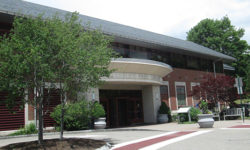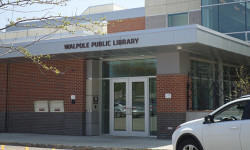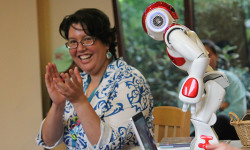[ccfic caption-text format="plaintext"]
By Laura Drinan
Hometown Weekly Reporter
The Wellesley Free Library invited guests to gaze at the night sky inside the library’s Wakelin Room on Tuesday, August 22, just before sunset. That may sound a bit strange, as the only star visible before nighttime falls is the sun, and because the library visitors were indoors in a room without any skylights or windows to see outside. With the help of Emily from Boston’s Museum of Science and the traveling planetarium, though, it was possible to spend the afternoon under the stars.
The traveling planetarium, also called the Star Lab, is a giant bubble with an entrance jutting out of its side. The Star Lab, much like a bounce-house, is inflated with air but holds a dome shape. Before entering the Star Lab, Emily greeted the curious event goers and established some rules so that the children and their parents knew what to expect during the event. After Emily ensured that everything was set up inside, she invited the families into the dark Star Lab, showing them where to sit as they entered.
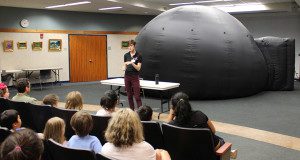
Wellesley Free Library visitors prepare for their indoor star gazing experience with the Museum of Science’s Star Lab.
Once settled, Emily projected pictures of the sun and the recent solar eclipse on the wall, asking the visitors if they knew about solar eclipses. As she showed pictures of how the earth looked during the solar eclipse, one girl asked about the temperature change during an eclipse. Surprisingly, an eclipse only causes a maximum temperature change of 10 degrees Fahrenheit. Emily also showed images of Saturn and Jupiter, and shared a chart on the temperature of stars based on their color.
To help the children recognize the different constellations in the sky, Emily projected what appeared to be a massive game of connect-the-dots onto the dome. The constellations had different colored lines connecting each star in the constellation to outline the shape of the constellation. Emily talked about one of the most famous cluster of stars: the Big Dipper. “The Big Dipper is inside a constellation, which means technically it is not a constellation [itself],” Emily explained. “Instead, it’s a part of Ursa Major, the bear in our sky.” After the children located the bear projected onto the southern edge of the dome, they were able to find the Big Dipper making up the rear end and tail of the bear.
The children and their parents were also able to locate Scorpius, the scorpion-looking constellation, and were taught to look for a red star at night, which is in the heart of the scorpion. To practice looking at a more realistic night sky, Emily swapped the projector for another one, which did not include any lines connecting the stars. Instead, the projector simply showed hundreds of twinkling stars on the dome’s interior. Again, the children searched for Scorpius, but instead of looking for the outline of a scorpion, they looked for the red star.
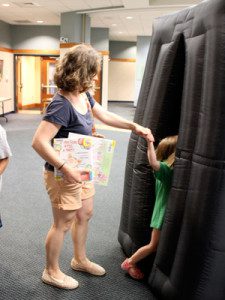
A young girl leads her mother into the Star Lab for an interactive and educational astronomy experience.
Whereas most around Massachusetts call the constellation “Scorpius,” Emily explained that not everyone around the globe would refer to it as such. In Hawaii and the Polynesian Islands, for example, they may call the constellation “Maui’s Hook,” which many of the traveling planetarium attendees recognized from Disney’s “Moana.”
Growing up in eastern Massachusetts, Emily always saw the Museum of Science as Boston’s beacon of science. Now, thanks to the Museum of Science’s mobile Star Lab, the young astronomers can look to the Wellesley Free Library as their local beacon of science and knowledge.






